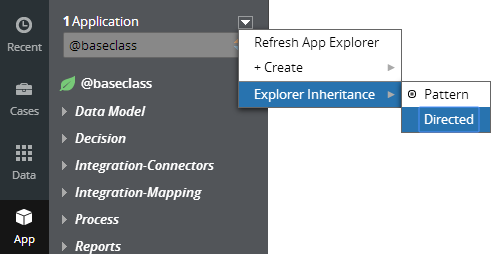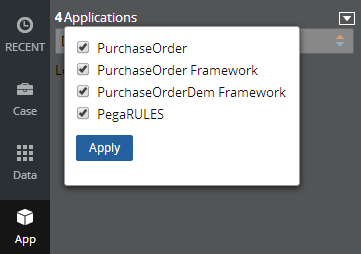Guardrails compliance score
Valid from Pega Version 7.1.5
The Application Guardrails landing page has been enhanced to help you build more guardrail-compliant applications. Increase transparency and accountability on your projects by responding to the following compliance score metrics:
- A weighted compliance score (0-100) based on warnings, severity, and justification
- A percentage of compliant rules in your application
- Total number of rules in your application
- Total number of rules in your application with warnings (justified and unjustified)
Additional metrics include alert and interaction count trends over the last four weeks.
For more information, see Guardrails compliance score.
Directed inheritance view in Application Explorer
Valid from Pega Version 7.1.5
You can now specify which inheritance model is used to populate classes in the Application Explorer. From the top level menu, use the “Explorer Inheritance” option to choose between:
- Pattern: only display class names whose prefix matches the root node class name.
- Directed: first display classes that explicitly name the root node as the parent class; then display classes with pattern inheritance.

By default, the Application Explorer loads using Pattern inheritance.
Save Application Explorer filter selections
Valid from Pega Version 7.1.5
Application scoping control selections made in the Application Explorer are now persisted between sessions. These preferences are stored in an operator record on an access group level. If you delete (and later re-add) an access group on your operator form, the application scoping control defaults to all layers selected:

External access control DASS
Valid from Pega Version 7.1.5
A new Dynamic Admin System Setting (DASS) controls the Designer Studio's access to external systems, specifically the PDN RSS feed found on the home page.
By default, Pega-Desktop.AllowAccessToExternalSystem is set to TRUE. Update this setting to FALSE to hide the PDN RSS feed and ensure that no RSS fetch is performed.
Support for rule rebasing
Valid from Pega Version 7.3.1
You can now rebase the rules on your development server with the most recently committed rules from a centralized system of record (SOR). For example, after rules are merged on the SOR, you can rebase your development application to refresh your application with the merged rules. Development teams working in two separate development environments can share their changes, keep their local rulebases synchronized, and reduce the probability of conflicts with other development teams.
For more information, see Rule rebasing.
Add new commands in the Facebook channel preview console
Valid from Pega Version 7.3.1
Now you can not only edit existing commands in the preview console for a Facebook channel but also add new command responses and associate them with intents. For example, you can add a new response command in the preview console in a case in which you entered a command and no response was found for the generated intent. This functionality gives you more control over the Facebook channel configuration and makes the preview console easier to use.
For more information, see Simulating a chatbot conversation.
Enhancements to PegaUnit test cases and test suites
Valid from Pega Version 7.3.1
Several enhancements have been made to PegaUnit test cases and test suites.
- You can now use advanced filters on the Automated Testing landing page and when you add test cases to a test suite to search for information.
- After you run a test case on the Edit Test Case form or a test suite on the Edit Test Suite form, the header now displays the expected and actual run-time values.
- You must now specify at least one assertion before you can save a test case.
- You can now compare a property to multiple values so that the assertion passes if any property meets the defined criteria.
- You can now use the is greater than and is less than comparators for date and date-time properties.
For more information about PegaUnit testing, see PegaUnit testing.
Execute Tests service now supports application name as a parameter
Valid from Pega Version 7.3.1
You can now use the application name and version as a parameter when running the Execute Tests service (REST API). When you build an application on Pega® Platform in a continuous delivery pipeline, you can use the Execute Tests service to validate the quality of the build by running PegaUnit test cases that are configured for the application.
For more information about the service, see Running PegaUnit test cases and test suites with the Execute Tests service in Pega 7.3.1.
Monitor application health on the Application Quality landing page
Valid from Pega Version 7.3.1
On the Application Quality landing page, you can view various quality-related data in one place so that you can monitor the quality of your application and correct any issues. The Application Quality landing page contains a summary of guardrails compliance, PegaUnit test coverage, and results of PegaUnit tests.
For more information, see Application Quality landing page.
View PegaUnit test reports
Valid from Pega Version 7.3.1
The Reports tab on the Automated Testing landing page contains tables and charts that display the percentage of rules on which PegaUnit test cases are configured, and the results of PegaUnit test execution. By looking at the data on this tab, you can see which tests failed and investigate them.
For more information, see Viewing PegaUnit reports.

